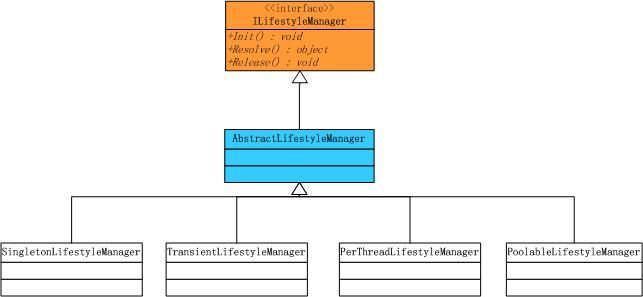Castle IOC容器组件生命周期管理
摘要:Castle IOC容器为我们提供了不同的生命处理方式以及组件生命周期的处理,即组件装载,初始化,销毁时所表现的行为。如何去使用它们?本文讲对这一内容进行详细的阐述。
主要内容
1.生命处理方式
2.自定义生命处理方式
3.生命周期处理
一.生命处理方式
我们通常创建一个组件的实例使用new关键字,这样每次创建出来的都是一个新的实例,如果想要组件只有一个实例,我们会使用Singleton模式。在Castle IOC中,它支持我们对于组件的实例进行控制,也就是说我们可以透明的管理一个组件拥有多少个实例。Castle IOC容器提供了如下几种生命处理方式:
l Singleton:一个组件只有一个实例被创建,所有请求的客户使用程序得到的都是同一个实例,同时这也是Castle IOC容器默认的一种处理方式。
l Transient:这种处理方式与我们平时使用new的效果是一样的,对于每次的请求得到的都是一个新的实例。
l PerThread:对于每一个线程来说是使用了Singleton,也就是每一个线程得到的都是同一个实例。
l Pooled:对象池的处理方式,对于不再需用的实例会保存到一个对象池中。
l Custom:自定义的生命处理方式。
我们可以通过以下两种方式来指定组件的生命处理方式,如果不指定,则为Singleton方式:
1.使用配置文件
 <!--
出处:http://terrylee.cnblogs.com
-->
<!--
出处:http://terrylee.cnblogs.com
-->

 <?
xml version="1.0" encoding="utf-8"
?>
<?
xml version="1.0" encoding="utf-8"
?>

 <
configuration
>
<
configuration
>

 <
components
>
<
components
>

 <
component
id
="comp1"
lifestyle
="transient"
>
<
component
id
="comp1"
lifestyle
="transient"
>

 <
parameters
>
<
parameters
>

 <
para
>
component1 para
</
para
>
<
para
>
component1 para
</
para
>

 </
parameters
>
</
parameters
>

 </
component
>
>
</
component
>
>
 </
components
>
</
components
>

 </
configuration
>
</
configuration
>
2.使用Attribute特性
 //
出处:
http://terrylee.cnblogs.com
//
出处:
http://terrylee.cnblogs.com

 [Transient]
[Transient]
 public
class
MyComponent
public
class
MyComponent

 {
{ public MyComponent()
public MyComponent()

 {
{ //
//

 }
} public MyComponent(string _Str)
public MyComponent(string _Str)

 {
{ //
//

 }
} }
}
前面在Castle IOC的内幕故事中我们说过,组件生命方式是由一个叫做LifestyleModelInspector的Contributor来管理的。在LifestyleModelInspector中我们注意到有这样一段代码:
 public
virtual
void
ProcessModel(IKernel kernel, ComponentModel model)
public
virtual
void
ProcessModel(IKernel kernel, ComponentModel model)

 {
{ if (!ReadLifestyleFromConfiguration(model))
if (!ReadLifestyleFromConfiguration(model))

 {
{ ReadLifestyleFromType(model);
ReadLifestyleFromType(model); }
} }
}

 protected
virtual
bool
ReadLifestyleFromConfiguration(ComponentModel model)
protected
virtual
bool
ReadLifestyleFromConfiguration(ComponentModel model)

 {
{ //
//

 }
}

 protected
virtual
void
ReadLifestyleFromType(ComponentModel model)
protected
virtual
void
ReadLifestyleFromType(ComponentModel model)

 {
{ //
//

 }
}
其中ReadLifestyleFromConfiguration()从配置文件读取,ReadLifestyleFromType()是从组件的特性读取。可以看到LifestyleModelInspector首先会去检查配置文件中的是否指定,如果已经指定了,就会直接返回,否则才去组件特性里面去查找。由此我们可以得出如下一条重要的结论:
如果同时在配置文件和组件的特性中指定组件生命处理方式,配置文件将覆盖类中特性指定的。
二.自定义生命处理方式
下面我们来看如何实现自定义的生命处理方式。在这之前,先来看一下生命处理方式中的类结构图:

图1
可以看到,所有生命处理方式都实现了接口ILifestyleManager:
 public
interface
ILifestyleManager : IDisposable
public
interface
ILifestyleManager : IDisposable

 {
{ void Init(IComponentActivator componentActivator, IKernel kernel);
void Init(IComponentActivator componentActivator, IKernel kernel);
 object Resolve();
object Resolve();
 void Release(object instance);
void Release(object instance);
 }
}
所以要实现自定义的生命处理方式,只要实现接口IlifestyleManager就可以了,来看一下Castle IOC官方网站提供的一种生命处理方式,实现了对于Web应用程序中的每一次Request都创建一个Singleton实例:
 public
class
PerWebRequestLifestyleManager : AbstractLifestyleManager
public
class
PerWebRequestLifestyleManager : AbstractLifestyleManager

 {
{ private string PerRequestObjectID = "PerRequestLifestyleManager_" + Guid.NewGuid().ToString();
private string PerRequestObjectID = "PerRequestLifestyleManager_" + Guid.NewGuid().ToString(); 
 public override object Resolve()
public override object Resolve()

 {
{ if(HttpContext.Current.Items[PerRequestObjectID] == null)
if(HttpContext.Current.Items[PerRequestObjectID] == null)

 {
{ // Create the actual object
// Create the actual object
 HttpContext.Current.Items[PerRequestObjectID] = base.Resolve();
HttpContext.Current.Items[PerRequestObjectID] = base.Resolve(); 
 }
} return HttpContext.Current.Items[PerRequestObjectID];
return HttpContext.Current.Items[PerRequestObjectID]; }
}
 public override void Dispose()
public override void Dispose()

 {
{ 
 }
} }
}
对于自定义的生命处理方式,在使用配置文件和特性指定的时候又有些不同
1.使用配置文件
 <!--
出处:http://terrylee.cnblogs.com
-->
<!--
出处:http://terrylee.cnblogs.com
-->

 <?
xml version="1.0" encoding="utf-8"
?>
<?
xml version="1.0" encoding="utf-8"
?>

 <
configuration
>
<
configuration
>

 <
components
>
<
components
>

 <
component
id
="myComponent"
<
component
id
="myComponent"

 type
="MyLib.MyComponent, MyLib"
type
="MyLib.MyComponent, MyLib"

 lifestyle
="custom"
lifestyle
="custom"

 customLifestyleType
="MyLib.PerWebRequestLifestyleManager, MyLib"
>
customLifestyleType
="MyLib.PerWebRequestLifestyleManager, MyLib"
>

 <
parameters
>
<
parameters
>

 <
para
>
component1 para
</
para
>
<
para
>
component1 para
</
para
>

 </
parameters
>
</
parameters
>

 </
component
>
</
component
>

 </
components
>
</
components
>

 </
configuration
>
</
configuration
>
2.使用Attribute特性
 //
出处:
http://terrylee.cnblogs.com
//
出处:
http://terrylee.cnblogs.com

 [CustomLifestyle(
typeof
(PerWebRequestLifestyleManager ) )]
[CustomLifestyle(
typeof
(PerWebRequestLifestyleManager ) )]
 public
class
MyComponent
public
class
MyComponent

 {
{ public MyComponent()
public MyComponent()

 {
{ //
//

 }
} //
//

 }
}
三.生命周期管理
Castle IOC同样是支持组件生命周期的管理,也就是在组件装载,初始化,销毁所出发的行为,分别对应三个接口:IInitializable,ISupportInitialize,IDisposable。这些接口被分为两组:Commission和Decommission:
Commission
l Castle.Model.IInitializable interface
l System.ComponentModel.ISupportInitialize
Decommission
l System.IDisposable
如果组件实现了这些接口,容器会自动在不同的生命周期调用他们。我们看下面这样一个例子:
 //
出处:
http://terrylee.cnblogs.com
//
出处:
http://terrylee.cnblogs.com

 [Transient]
[Transient]
 public
class
MyComponent : IInitializable, IDisposable
public
class
MyComponent : IInitializable, IDisposable

 {
{ public MyComponent(string _para)
public MyComponent(string _para)

 {
{ //
//

 }
}
 public void Initialize()
public void Initialize()

 {
{ //
//

 }
}
 public void Dispose()
public void Dispose()

 {
{ //
//

 }
} }
}
在我们使用组件时
 //
出处:
http://terrylee.cnblogs.com
//
出处:
http://terrylee.cnblogs.com

 public
class
App
public
class
App

 {
{ public static void Main()
public static void Main()

 {
{ IWindsorContainer container = new WindsorContainer(new XmlInterpreter("http://www.cnblogs.com/BasicUsage.xml") );
IWindsorContainer container = new WindsorContainer(new XmlInterpreter("http://www.cnblogs.com/BasicUsage.xml") );
 container.AddComponent( "myComponent",
container.AddComponent( "myComponent", 
 typeof(MyComponent));
typeof(MyComponent));
 // Initialize()方法会自动执行
// Initialize()方法会自动执行
 MyComponent instince = container["myComponent"] as MyComponent;
MyComponent instince = container["myComponent"] as MyComponent;
 // Dispose()方法会自动执行
// Dispose()方法会自动执行
 container.Release(instince);
container.Release(instince);
 }
} }
}
关于Castle IOC容器组件生命周期管理就介绍到这里了。
参考资料
Castle的官方网站http://www.castleproject.org